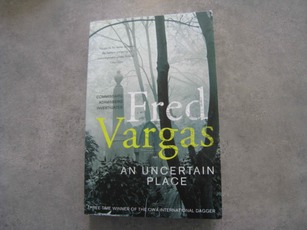Tuesday, 28 June 2011

Towards the end of An Uncertain Place, having cracked the case and tied the ends together, Commissaire Adamsberg phones the Serb translator who has helped sort things out. Asked about plans for the future, the translator replies that he's off to a conference and will be back on the straight and narrow which as you know does not exist and is neither straight nor narrow.
Which is, looking at it, a remarkably accurate summary of both existence and your typical Adamsberg story.
In both cases there's an apparent progression through a seemingly continuous narrative which simultaneously unfolds and jumps from place to place without apparent rhyme or reason as influences you thought were unrelated turn out to be intertwined.
You can, of course, take most detective novels and reduce them to a straightforward formulaic plot line. Detective is presented with challenging case and solves the mystery which turns out to have an unexpected element or consequence.
The first thing your average writer will do is to throw that plot line into an environment with a group of characters whose interactions are going to keep things going and add subplots and other intriguing influences to the mix.
Fred Vargas (the nom de plume of French historian and archaeologist Frédérique Audouin-Rouzeau), as anyone who has read her fiction knows, does all that at the start and then takes things off in directions that increasingly defy your expectations even when, having read everything you've been able to get your hands on. you don't actually have any.
My invariable reaction to an Adamsberg story is to scratch my head and ask myself how the (expletive deleted) could anyone come up with that?
For a start, having noted the rise of a substantial genre involving (teenage? dunno, haven't actually read, not really interested) vampires I hadn't anticipated reading any of it since that whole Nosferatu/Vlad the Impaler thing doesn't really float my boat, yet here we are wandering off to not-quite-Transylvania to track down a case that seemingly involves interactions between and among the undead and their legacy.
Then there's the strange coincidence of people who've got it in for Adamsberg who turn out to be related in unexpected ways, and not necessarily related to Adamsberg.
Or not. As the case may be.
The key point is, I think, that when you pick up an Adamsberg novel you know you're headed for strange territory, so it's a case of suspending logic and any set of expectations and settle down for the ride.
Put bluntly, this time around Adamsberg starts off at a a three-day conference in London where he encounters (shock! horror!) a macabre, bizarre and brutal case. Returning to Paris he encounters a second case which turns out to be related to the first one and needs an excursion to Serbia to tie the elements together.
Oh, yes, and the whole thing centres around the undead and represents the culmination of themes that run back a couple of centuries.
Along the way you know you're going to encounter an extravagance of eccentricities, and once again they're present in spades. Adamsberg, for a start, blithely wanders through a conference conducted in a language he doesn't speak while his translator, the encyclopedic Danglard becomes smitten by a female participant whose name appears to be Abstract. Apart from his lack of English, there's Adamsberg's inability to remember precise detail, so New Scotland Yard's Inspector Radstock becomes Stock, and London's baroque old Highgate Cemetery becomes Higg-gate. It's all in the detail, you see.